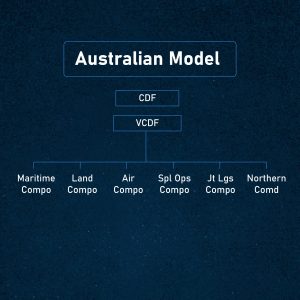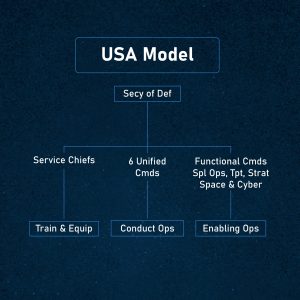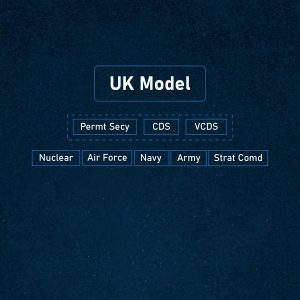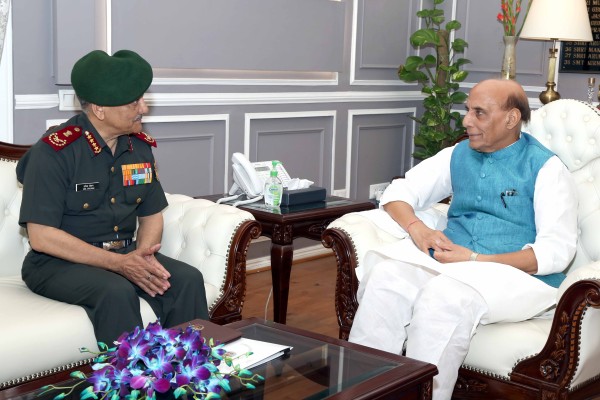NEW DELHI: Related to the restructuring of HQ IDS (Integrated Defence Staff) is the possibility of forming a higher defence committee for strategic and political guidance to the military leadership. Assuming that HQ IDS in consultation with the theatre commands will take local and largely tactical decisions, there is still no clarity on who or which organisation the Vice Chief of Defence Force (VCDF) or Vice Chief of Defence Staff (VCDS) will report to. Models implemented by the Anglo-Saxon nations do offer some clues but given the peculiarity of the Indian context (two or one-and-a-half hostile nations on its borders), a completely new structure drawing from various elements that are in vogue, may have to be evolved.



For instance, in the U.S. structure, the Secretary of Defence (SecDef) exercises direct command and control of the armed forces (see charts). The Australians too follow a somewhat similar system with the Chief of Defence Force (CDF) reporting to the Minister of Defence. He also commands the Australian Defence Forces through the Vice Chief of Defence Forces (VCDF). The UK model is however more collegiate. The CDS remains principal military adviser but the Permanent Secretary of Defence (a civilian) is the principal policy adviser with the same status as the CDS. The third parallel office at the top of the heap is that of the VCDS. The three collectively command the British armed forces.
In the Indian context, the U.S. model is unlikely to be considered given that the Raksha Mantri is mostly an experienced and senior politician without substantial experience in matters military.
One option that may have to be considered is to form a higher defence committee comprising key players in the national security apparatus. Can such a committee comprising—for example– the National Security Adviser (NSA), the Cabinet Secretary, the Principal Secretary to the Prime Minister, the CDS and the three service chiefs—be an answer to the conundrum? Other important officials, the Foreign, Home and Defence Secretaries, along with the heads of the Intelligence Bureau (IB) and the Research and Analyses (R&AW) can be permanent invitees.
A higher defence committee may be able to provide the much required civil interface to the military—a necessary prerequisite in a robust democracy like India. Fundamentally, the political class in India is more comfortable with a diffused power structure of the military and it is necessary to provide comfort to the government. Creation of a higher defence committee may require tweaking some of the existing arrangements/structures such as the National Security Council, the Strategic Policy Group and even the National Security Advisory Board.
It is nobody’s case that the role of the CDS or the Chiefs of Staff Committee (CoSC) should be diluted. They must continue to guide the theatre commanders and HQ IDS in policy and functional matters but permission from the proposed higher defence committee and if necessary, the CCS is a must for operational requirements that may need political clearance.
Critics might argue that such an arrangement will add another layer to the chain of command and may delay quick decision-making. But that is a risk that may be necessary to be taken in a functioning democracy.
Whatever the merit of these different arguments, Indian national security managers will have to come to a definite conclusion soon if the theatre commands are to be raised in a given time frame.
As the military brass wracks its brains in laying out the exact contours of HQ IDS, the role of CDS and the three service chiefs, the task of getting a functional and effective structure of theatre commands is equally vital. Placing the theatre commanders in an appropriate rank and empowering them adequately will be crucial to implementing India’s ambitious plans to optimise resources and increase combat effectiveness of its armed forces.
This task is easier debated than achieved though. One proposal is to make theatre commanders four-star officers on a par with Service Chiefs with their retirement age as 62, equivalent to service chiefs. Taking this leap of faith will require both political heft and administrative deftness within the military hierarchy.
One of the foremost challenges would be to subsume/place the current 17 regional commands across the three services and choosing theatre commanders without disturbing existing seniority principle. The second track involves integrating methods, processes and operating procedures, achieving commonality in logistics and human resource policies and assessing annual performance, just to mention a few.
As a former military officer and scholar at the Institute of Defence Studies and Analyses (IDSA) Vivek Chadha has said in a book authored in 2021, “it is felt that theatre commanders should be four-star rank officers with similar seniority as the Service Chiefs. It will facilitate the necessary coordination and command and control within the theatres. This includes command over certain regional commands that could be created or retained. This may include the Andaman and Nicobar Islands or perhaps even areas like Jammu and Kashmir to cater to the specific requirements of countering terrorism. It is also important to co-relate their functioning with existing service chiefs. It is initially envisaged that the Service Chiefs will continue to guide operational aspects as part of the Chiefs of Staff Committee. Over time, their role will shift to raise, train and sustain function. The evolving relationship between the CDS and Service Chiefs suggests that having four-star theatre commanders will not become a constraint for ensuring a smooth functional relationship between them and the Service Chiefs.”
Other scholars such as RAdm Sudarshan Shrikhande (retd) have written for us in BharatShakti.in extensively on this debate and have come to a conclusion that eventually:
- The Service Chiefs would transit to the primary, but equally vital roles of “Raise/Train/Sustain” and shed a large part of their operational roles in conflict to HQ IDS/joint theatre commands or JTCs.
- All the functions of the SHQs would benefit from the central strategy planning process for overall military strategies in terms of force planning and force-building processes. Among other things, this would help true indigenization and self- reliance without which India cannot be a great power.
- An important consequence of integration and jointness could be—rather must be—the rise in effectiveness accompanied by the optimisation of personnel strength.
In his address to the annual DRDO Directors’ Conclave, CDS General Anil Chauhan recently talked about the importance of theaterisation of conflict. He said: “The concept of theaterisation is a fundamental change that is on the anvil… Theaterisation involves the creation of tri-service theatre-specific structures for effective response along the entire spectrum of conflict.”
If that is the fundamental aim, there would be no better way of handling the business of joint military outputs across the spectrum of peace and conflict than creating joint theatre commands, no matter what it takes.
(This is the concluding part of a two-part exclusive series on theaterisation)
Related Links:
Nitin A. Gokhale is a media entrepreneur, one of South Asia's leading strategic affairs analyst and author of over a dozen books so far on military history, insurgencies and wars.
Starting his career in journalism in 1983, he has since led teams of journalists across media platforms.
A specialist in conflict coverage, Gokhale has covered the insurgencies in India’s North-East, the 1999 Kargil conflict and Sri Lanka’s Eelam War IV between 2006-2009.
Gokhale now travels across the globe to speak at seminars and conferences, and lecture at India’s premier defence colleges. He has founded three niche portals, Bharatshakti.in, stratnewsglobal.com and Interstellar.news.





